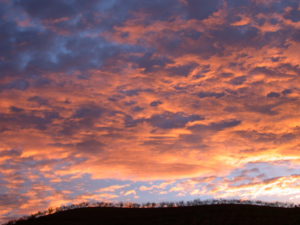
We have been recording climate details since 2002: temperatures, humidity, sunlight, rainfall, windspeed and direction from themeteorological stationsituated among the fig trees above the driveway. There are 14 weather stations in Granada Province and if we examine the data it gives the lie to the well known saying “anything is possible in Granada” where on the same day in the same province one can enjoy temperatures of 20 degrees on the coast (Costa Tropical) and – 10 degrees in the Sierra Nevada.
Summer is the busiest season in the Alpujarra when the local population works and often lives on the land. In winter everyone is back in the village and returns to communal life. Spring and Autumn are intense with agricultural preparation and preoccupation. Most notable is the marked difference between the seasons, and the variety of human activity strongly tied to the demands of nature.
SPRING:
 In March we start to feel the heat of the sun, the trees are in full bud and the scent of almond blossom still lingers: but it is said “Cuando marzo mayea, mayo marcea” when March is like May, May will be like March. The agricultural cycle starts again in earnest; weeding the broad bean seedlings, sowing potatoes, peas and pruning the vines.
In March we start to feel the heat of the sun, the trees are in full bud and the scent of almond blossom still lingers: but it is said “Cuando marzo mayea, mayo marcea” when March is like May, May will be like March. The agricultural cycle starts again in earnest; weeding the broad bean seedlings, sowing potatoes, peas and pruning the vines.
The first swallows usually arrive around the 6 March with the warmer air, although in 2008 they came over a week later.
At the Alqueria the silk worms emerge around about el dia de San Jose (St Joseph’s Day), at the same time as the soft mulberry tree leaves, on which they feed, come out.
April sees the arrival of solitary bees, honey bees, lilies, and swifts, but in 2002 the swifts came unusually early on 18 February due to a very mild winter with almost no snow remaining in the Sierra.
In 2006 Spring seemed to have arrived on 8 March when the almond trees were in late full blossom so joining the plum trees in swathing the countryside in a sweet scented pink and white blanket of flowers.
By the beginning of April the headwater of the Guadalfeo river is noticeably diminished as water is taken off upstream to irrigate the recently planted seedlings.
SUMMER:

Summer starts with the first cherries. July, August and September is the hottest time of year when the bulk of the agricultural produce of the Alpujarra is collected; figs, tomatoes, almonds, grapes, walnuts, soft fruit, etc.
Wheat is threshed in August and the rye grass is sythed; chick peas and early potatoes are gathered. The grape harvest is in September – we pick in the early mornings and start pressing in the early evening after a hearty lunch.
The summer of 2003 was one of the hottest on record, on a couple of days the temperatures reached 38.5 degrees. Thankfully 2004 was cooler and wetter.
On 13 September, but sometimes later, the swallows depart, leaving behind their laboriously built nests – no matter that the mean temperatures are still as hot as Summer, nature tells them to go.
AUTUMN:

Autumn is the most spectacular season in the Alpujarra, when the leaves of the many poplars, maples, elms, chestnuts and vines at the Alqueria turn red, honey, gold and yellow. Sunsets are magnificent with their rich pink light.
Smoke is seen swirling from the chimney pots and folk sit around their hearths roasting chestnuts. But the kitchen gardens are still productive giving red and green peppers, tomatoes, aubergines, and pumpkins, strawberries and kiwifruits. There are green beans in the Sierra and and almonds on the dry lands.
When the soil releases its summer heat and combines with the fresh airs wafting down from the Sierra it produces a delightful sensation of enchantment in the golden air.
WINTER:

The first snowfalls are usually mid December. This year has been exceptional with three heavy snowfalls since the beginning of the year. The nearby Sierra Nevada directly opposite the Alqueria is still thickly covered.
In January we collect the olives which are then milled in our own press, and we plant garlics in the kitchen garden.
Some years the almond trees blossom in early January, as in 2003, but the flowers are usually at their most impressive mid to late February. The willows, elms and ash trees are now beginning to bud.
In March the first flowers start to come out, such as batchelors buttons, violets and purple flowering cabbage. Although not in 2003 which was cold and rainy, it even snowed at the Alqueria – although we took advantage of the wet to plant another hectare of vines as well as our annual planting of trees and shrubs.

